A space for sharing my journey as a facilitator and all that impacts it :)
Wednesday, December 17, 2008
Thursday, December 11, 2008
Celebrating International Volunteer Day
5 December was a special day for my organization--The International Volunteer Day--a day to celebrate the efforts and impact made by volunteers! We supported the celebrations five states across in Nigeria including Lagos. Given all the madness that comes with getting 20 NGOs to work together, we somehow managed to pull off the program.
Attended by about 160 individuals & organizations, 21 media reps; we got the fabulous Crowne Troupe of Africa to perform a hilarious however brutally real dance drama. The highlight for me personally was when we awarded six volunteers Recognition Awards, it was the first time such awards were being presented in Nigeria (so I think!) . A couple of volunteers also shot a video taking glimpses of the events and interviews with the organizations, volunteers and media--which should add to developing the first documentary on national volunteering in Nigeria!
Though my anxiety levels were shooting the roof, the onsite volunteers were agile, attentive and very quick to deal with all that could go wrong--including the soundless PA system and the rain! We already are getting fantastic coverage in media and managed to make some solid contacts.

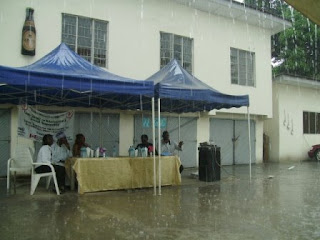




Attended by about 160 individuals & organizations, 21 media reps; we got the fabulous Crowne Troupe of Africa to perform a hilarious however brutally real dance drama. The highlight for me personally was when we awarded six volunteers Recognition Awards, it was the first time such awards were being presented in Nigeria (so I think!) . A couple of volunteers also shot a video taking glimpses of the events and interviews with the organizations, volunteers and media--which should add to developing the first documentary on national volunteering in Nigeria!
Though my anxiety levels were shooting the roof, the onsite volunteers were agile, attentive and very quick to deal with all that could go wrong--including the soundless PA system and the rain! We already are getting fantastic coverage in media and managed to make some solid contacts.

Wednesday, December 10, 2008
Osogbo: The Art Heart of Nigeria
Osogbo in its heyday, was the flourishing centre of the Osogbo School of Art, a movement which started in the 1960s. It has attracted and produced many internationally acclaimed artists. We visited two prominent art galleries. The first was a two-storey belonging to Nike Davies. It had a dazzling collection of paintings, sculptures, woodworks, clothes, bronze work which were obviously prized for the the expat's budget! It mirrored the vibrancy and ethnicity of Nike's house cum gallery in Lagos. The second one we visited was the home cum gallery of Chief Jimoh Buraimoh, the inventor of the bead paintings! One of the paintings we all fell in love with was priced at Naira 500,000! It took us a while to convince them that we were volunteers with little money! Luckily for us the Chief was home and we had a nice chat with him about his works and life in Osogbo. We were actually also staying in his hotel. The home visit got us an invitation to a special program that evening in the honour of a Osogbo American who is developing a Osogbo village in Florida. We witnessed a pulsating dance and music performance by a local group that performs at the Osun Festival.


Tuesday, December 9, 2008
The Serene Sacred Groves of Osogbo
The quiet town of Osogbo in Osun State (about four hours north of Lagos) is world renowned for two things: its vibrant art galleries and the serene Sacred Groves. It has been on my travel agenda since I came to Nigeria and finally with some other VSO volunteers, we finally managed to go!
As the name suggests, the 75-acre Osun Sacred Groves is a cool green oasis is adorned with sculptures and shrines of Yoruba deities, particularly the river Goddess Osun (Mother of Osogbo) who according to legend, promised the protection of the town. The area of the forest was home to early settlers and founders of Osogbo 400 years ago where the history of the town was recorded. Each sculpture and shrine created by local and international artists (primarily Austrian Susanne Wenger settled in Nigeria since the 50s) represents the activities, lives and preoccupations of the Gods and Goddesses of the Groves. The forest was declared a world heritage site in 2005 by UNESCO. The annual Osun Festival held in August attracts thousands of visitors from Nigeria and abroad.
We had a delightful albeit restricted walk through the forest along with a guide (who was stumped by our barrage of questions). I will make a feeble attempt to explain the sculptures and shrines given my bad memory with the tight lipped guide.
Below is the Goddess of Fertility, with many babies & children sculpted with her.
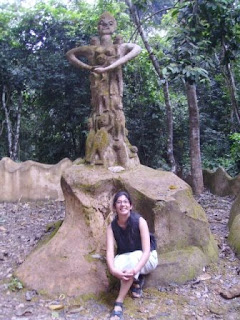 We then walked through a large opening with a sculpted gate that led to the Oba's (King) palace below.
We then walked through a large opening with a sculpted gate that led to the Oba's (King) palace below.
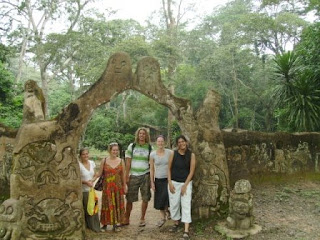
 Just beyond the palace is the Osun river. Below is the Osun Goddess with a fish shaped bottom. During the festival, the Oba sits in the special seat and accepts the water from the mouth of fish who apparently come to that spot only during the festival.
Just beyond the palace is the Osun river. Below is the Osun Goddess with a fish shaped bottom. During the festival, the Oba sits in the special seat and accepts the water from the mouth of fish who apparently come to that spot only during the festival.

 Wandering forward, we came upon a colonial swingy suspension bridge built in 1935 by a Welsh District Officer. The oracle grove at the end of the bridge was closed to us reserved only for the diviners or oracle.
Wandering forward, we came upon a colonial swingy suspension bridge built in 1935 by a Welsh District Officer. The oracle grove at the end of the bridge was closed to us reserved only for the diviners or oracle.
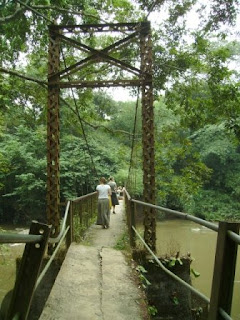
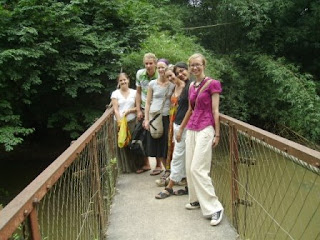 In another part of the forests, were four rather complicated large sculptures. The first one you see is the Goddess called "Iya Maapo", the protector and patroness of all women's craft and trade including child birth. Her three outstretched hands symbolize advice, blessing and regrets.
In another part of the forests, were four rather complicated large sculptures. The first one you see is the Goddess called "Iya Maapo", the protector and patroness of all women's craft and trade including child birth. Her three outstretched hands symbolize advice, blessing and regrets.
 The next one imposing statue is the tall, elegant and slender ELA portraying dynamism of the Ifa God. The upwardly hands denotes his offering/ pleading to the Gods above.
The next one imposing statue is the tall, elegant and slender ELA portraying dynamism of the Ifa God. The upwardly hands denotes his offering/ pleading to the Gods above.
 The last of the massive trios was the most complicated in design and symbolism--the youthful and intricate force God of Alajere and representing the chicken pox!
The last of the massive trios was the most complicated in design and symbolism--the youthful and intricate force God of Alajere and representing the chicken pox!
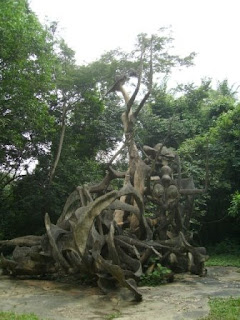 On our way out, we saw the same stream of surreal sculptures along the road.
On our way out, we saw the same stream of surreal sculptures along the road.
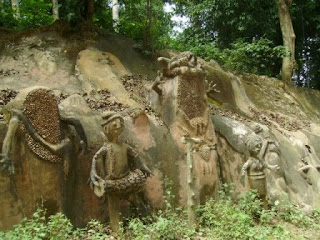
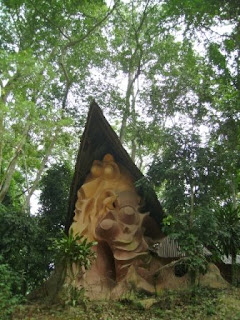 Along with the black monkeys and butterflies, the forests were a live walk through the rich and diverse history of the divine lives of the Yorubas.
Along with the black monkeys and butterflies, the forests were a live walk through the rich and diverse history of the divine lives of the Yorubas.
Below you see the well known and eerie home of Suzanne Wenger which also houses a more random collection of sculptures, art and other traditional trinkets some of which were in our budget range!
As the name suggests, the 75-acre Osun Sacred Groves is a cool green oasis is adorned with sculptures and shrines of Yoruba deities, particularly the river Goddess Osun (Mother of Osogbo) who according to legend, promised the protection of the town. The area of the forest was home to early settlers and founders of Osogbo 400 years ago where the history of the town was recorded. Each sculpture and shrine created by local and international artists (primarily Austrian Susanne Wenger settled in Nigeria since the 50s) represents the activities, lives and preoccupations of the Gods and Goddesses of the Groves. The forest was declared a world heritage site in 2005 by UNESCO. The annual Osun Festival held in August attracts thousands of visitors from Nigeria and abroad.
We had a delightful albeit restricted walk through the forest along with a guide (who was stumped by our barrage of questions). I will make a feeble attempt to explain the sculptures and shrines given my bad memory with the tight lipped guide.
Below is the Goddess of Fertility, with many babies & children sculpted with her.
Below you see the well known and eerie home of Suzanne Wenger which also houses a more random collection of sculptures, art and other traditional trinkets some of which were in our budget range!
Subscribe to:
Posts (Atom)